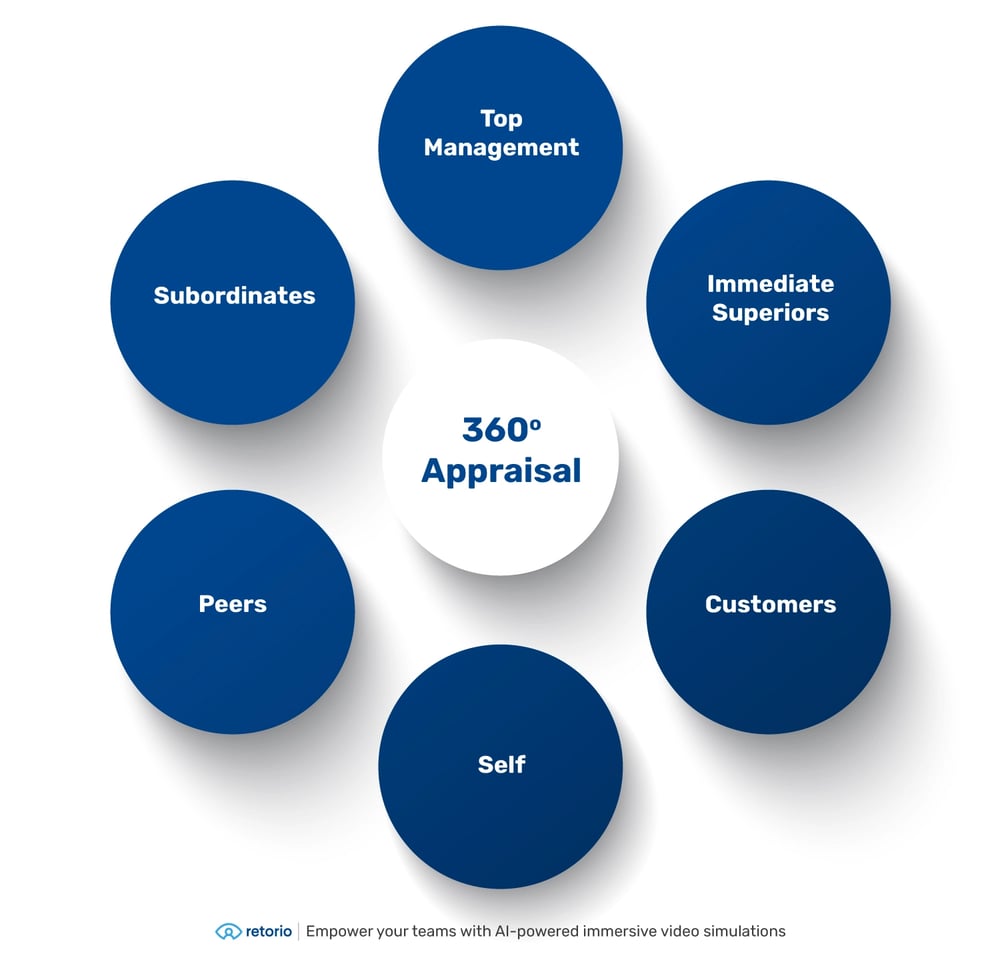Performance appraisals, also known as performance reviews are an essential part of managing efficient performance management. Performance appraisals are tools that are used for measuring an employee's performance over a specific period of time, setting goals, and providing a safe space for feedback where you as the manager can support their productivity and development.
If a performance appraisal is conducted efficiently, the performance appraisal process will automatically encourage open conversations between you and your employees. This will result in boosted employee performance, better employee engagement, and better work outcomes in the long run.

However, the performance appraisal process can be challenging and time-consuming, and there is always a concern about what comes first and last.
That is why this blog post is here to give you a thorough explanation of the steps of the entire performance appraisal process so that you will be more than prepared to confidently conduct your next one.
We also include a section on the benefits of a performance appraisal, so be sure to check that out as well!
What's in this post?
What is the performance appraisal process?
Before we dive into the steps of a performance appraisal process, let's begin with what a performance appraisal process actually is.
The performance appraisal process is a system implemented in HRM that is used to analyze and assess employee performance in order to help promote their future development potential. A performance appraisal process often includes performance metrics or performance ratings
A performance evaluation often begins with the manager and employee identifying objectives together to measure how well each employee carries out their duties and obligations. The starting point of a performance appraisal is to establish clear criteria that include the performance standards and expectations of what each employee aims to achieve.
The process then concludes with an annual (or quarterly) review of the employee's performance and thorough feedback from both the company and the employee themselves. In some cases, 360 feedback is received from peers and direct reports as well.
Performance appraisals are a valuable tool for managers to ensure that their employees are reaching their expectations and goals in a certain time frame. It allows employees to also conduct their own self-evaluation throughout the appraisal process in seeing where their strengths and areas of improvement lie.
On the other hand, performance appraisals are also essential for managers to take the time to recognize the hard work of their employees and reward them for their dedication.
 A performance appraisal is a two-way dialogue. Therefore, developing on your communication skills to ensure a productive and positive dialogue is vital for a successful appraisal cycle.
A performance appraisal is a two-way dialogue. Therefore, developing on your communication skills to ensure a productive and positive dialogue is vital for a successful appraisal cycle. The performance appraisal process
The performance appraisal process is very much customizable depending on how you would like to approach it according to your own leadership style. You can also implement various performance appraisal methods for each performance review process as well. However, these six steps are the foundations of every performance appraisal that addresses performance expectations and professional development.
Define performance criteria
By performance criteria, we mean performance standards. Performance standards are necessary for each job position to ensure that your employee's performance is fulfilling the missions and vision of your company. This criterion is established through the job description, employee handbooks, or objectives that were set at the beginning of an employee's journey at the company.
When it comes to defining performance criteria, make sure that the criteria are clear and measurable. Each task should include goals, and they would be achievable and measurable within a certain time period. Having concise performance criteria will help you and your employees to look back on the employees' performance during the appraisal meeting and see how their actual performance aligns with the performance criteria.
Doing so will help you quickly identify the areas of strengths and areas of improvement and work together towards a better work quality and positive outcome.
Remember that performance criteria should be fair and unbiased!
Communicate performance standards
In order to have an effective employee performance appraisal process, having clear performance criteria is not enough. It is also vital for you to clearly communicate the performance standards to your employees and make sure that they understand all that is expected of them. Make room for any questions they may have and space for ideas that can be discussed around each standard.
Allow employees to give feedback on their set goals what is achievable for them, and how they can best approach it with your support. The communication should be a two-way dialogue where doubts and concerns can be expressed openly.
When communicating the performance standards, you can also take the opportunity to discuss training opportunities that can help improve an employee's job performance and career development. As a result, you can see how you can provide training programs that will help them reach their performance standards.
With that being said, if training takes place, be sure to communicate your expectations of improvement as well.
Measure performance progress
After communicating the performance standards to your employees, it is important to also measure their progress. You can regularly analyze employee performance on a regular basis by tracking their attendance weekly (if that is a standard they are aiming to meet), and review their sales goals monthly.
As a manager, you can decide how frequently the performance criteria are reviewed based on how they affect the business achievement. This can also depend on how well your employees are performing. If you see that they are progressing that a steady rate, you can have less frequent check-ins. However, if you are noticing that they are falling behind, you can have more frequent follow-ups, and step in to give them a reminder to stay on top of their goals (keep them accountable for their progress).
Remember - this is not micromanaging. The assessment process is an ongoing one, therefore, to ensure a successful performance appraisal process, measuring performance progress is key to keeping employees aligned with the company's objectives.
Compare performance progress to performance criteria
All employees are unique and develop in their own place. Therefore, it is never a good idea to compare one employee to another as this can cause demotivation, conflict, and tension between you and your employees and even amongst employees themselves.
Nonetheless, when we say "compare" we mean comparing one progress to the goals that they set according to the performance criteria. A good mindset to cultivate is that every employee is competing with themselves. Therefore, a performance criteria is there to help you keep your employees on the right side of the track.
When comparing an employee's performance progress to the performance criteria, they can begin to reflect on what roadblocks or obstacles they have faced that may have hindered their performance, or exactly what was helpful that boosted their progress over time.
Moreover, fair performance criteria also help you stay unbiased during performance evaluations. You can compare their progress to an established reference with the ideal performance standard, and pinpoint exactly where improvement is still sought after or what has already been achieved, therefore ticked off.
Discuss performance results and provide feedback
Performance appraisals is the optimal time for you to provide regular feedback to your employees. Discuss their actual performance, and offer constructive feedback rather than negative feedback. Reward what each employee achieved and encourage them to keep up the good work for a successful future performance.
When conveying feedback, make sure to address them in a professional and positive manner. Be uplifting rather than purely critical. The way you communicate feedback and praise matters during employee performance appraisals as it sets the tone for all check-ins and future performance appraisals.
When providing feedback, also think about L&D opportunities that can be beneficial to boost organizational performance as a whole. What development tools can you provide employees for upskilling? What training is missing? How can you improve a training experience so that they are more personalized and effective for each individual learning journey?
Conclude with a follow-up plan
A performance appraisal does not end after each conversation is over because learning is continuous and there is always room for improvement and learning new skills for future growth and a better overall performance.
As mentioned before, regular follow-ups are important and essential in keeping your employees on track and measuring their progress, however, if you only plan on having one follow-up, set up a plan on what should be achieved by then, how it will be done and what the first steps are.
Again, with that being said, make a plan of action for future performance evaluations. Create larger goals centered on employee success and give concrete plans of action where improvement is still required. That way the next steps are clear and both you and your employee can leave the meeting feeling fulfilled, understood, and clear-headed on new expectations and how to target them.
You can also encourage employees to invest in their own development by including their personal goals for themselves, and what they expect of you as a manager to support them in their progress. By the end of the follow-up plan, the performance appraisal should feel like you have come a full 360 degrees with your employee. Goals are set, expectations are clear, and a plan of action is ready to take place.
 Performance appraisals should leave employees feeling empowered, and motivated to grow. Let's turn around the old expectation of performance reviews being horrible into a session that employees look forward to attending.
Performance appraisals should leave employees feeling empowered, and motivated to grow. Let's turn around the old expectation of performance reviews being horrible into a session that employees look forward to attending. Benefits of a performance appraisal
Performance appraisals have not always been appreciated or praised by managers in the past. This is because traditional performance appraisals can be challenging and nerve-wracking to handle. However, the modern performance appraisal method offers organizations a fountain of benefits that help in assessing employee performance in a more effective and efficient manner.
Before we dive into the benefits of a performance appraisal, here are some statistics by Betterworks showing the advantages that performance reviews have to offer to organizations around the globe.
Companies that implement continuous performance feedback have outperformed their competitors at a 24% higher rate.
This is the result of the consistent, constructive feedback that is being communicated during each appraisal cycle and expectations that are being set which align with the company's objective.
Organizations with continuous performance appraisal procedures recruit 39% more top talent and are 44% more effective at retaining top talent.
This is due to managers being able to identify the traits and skills of each top-performing employee and keep that in mind for new and future hires. Moreover, once the success and strengths of each top-performing employee are recognized and rewarded, managers ensure to nurture those skills and foster continuous development within the organization.
HR teams who adopt continuous employee performance appraisals experienced a 50% boost in "excellent" evaluations for their managers.
Performance appraisals allow for conversations to flow. Therefore, employees also get the opportunity to give feedback to their managers on where they can improve, and how they can become better leaders. If implemented well, managers can also work on self-improvement to increase efficiency in their job position.
A performance appraisal should be a priority to master. Not only does it build a strong and open relationship with your team, but it also boosts morale and teamwork which in turn increases the positivity rank of your company's culture.
Retorio's AI Coaching platform enables you to improve your communication skills when it comes to something as important as performance appraisals and immerses you in real-life scenarios with employees through role-play. Along with personalized feedback and a safe space to conduct your training, the Retorios AI-powered platform is ready to shape you into a master-level manager in no time at all. It's truly as easy and efficient as that! Don't believe us just yet? click on the button below to get started right away and see for yourself!
FAQ
Performance reviews are normally conducted once a year. However, to increase productivity, experts recommend companies conduct performance reviews every 6 months with smaller check-ins in between if necessary.
Each step of the performance appraisal is important because they are all interconnected and play a crucial role in the success of each employee i.e. the success of the organization. However, the one step that is at the heart of the process is defining the performance criteria. This is because if there are little or no standards set for how employees should perform to deliver optimal results, managers and employees may set goals and make future decisions based on emotional responses or let biases get in the way.




